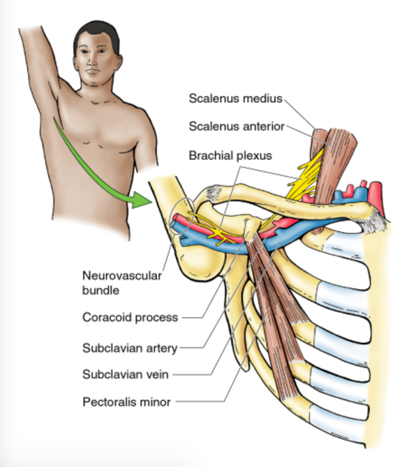What is thoracic outlet syndrome, what causes it and how do we manage it?
There are several “passageways” in the neck and shoulder where nerves and blood vessels pass through. These passageways are made up of soft tissue and bony structures including the ribs, the collarbone and the musculature of the neck and shoulder, as shown in the picture below. In the case of TOS, there is compression of the neural and vascular structures as they exit through the passageways.
Symptoms vary from patient to patient depending on what structures are affected. In rare cases, there can be limb-threatening complications if blood vessels are severely compromised. However, almost all cases of TOS affect the brachial plexus – the cluster of nerve roots exiting from the cervical spine. Most patients will present with pain in the neck, face, chest or shoulder, often accompanied by altered or absent sensation in the upper limb. Patients can also report a feeling of heaviness in the arm and hand with or without weakness of the limb. These symptoms can be worse when the arm is in an overhead position.
There are several factors that can cause TOS, some include:
- Tightness or shortening of the musculature in the front of the chest and the neck including the pec minor and scalenes (see image)
- Anatomical/structural abnormalities present from birth such as cervical ribs (extra ribs)
- Postural factors such as rounded shoulders or altered spinal curvatures
- Dropped shoulders
- Whiplash or hyperextension injury of the neck
The overall management of this condition will depend on the severity of the patient’s symptoms and the type of TOS. Physiotherapy management focuses on:
- Postural control
- Pain management
- Education regarding breathing patterns and sleeping positions
- Nerve gliding techniques
- Massaging, stretching and strengthening various muscles around the neck and shoulder girdle to aid in reducing compression of the neural and vascular structures
TOS can have a significant impact on your quality of life by limiting your ability to complete day-to-day tasks or preventing you from being able to participate in your sport of choice. It is important to address these symptoms and work with your healthcare professional to develop an appropriate management plan for you.

